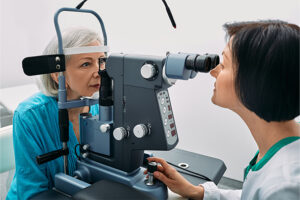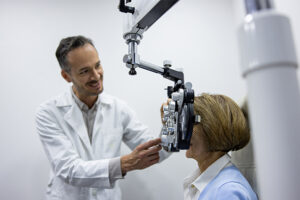Ophthalmology
Neovascular Age-Related Macular Degeneration and Diabetic Macular Edema
Updates in Clinical Imaging of the Retina: Correlating Images and Disease
Overview
Optical coherence tomography (OCT) and OCT angiography (OCTA) permit sophisticated structural visualization in diabetic macular edema (DME) and neovascular age-related macular degeneration (nAMD). Continued advancements in retinal imaging and analytics are improving our ability to detect, evaluate, and monitor retinal diseases.
Expert Commentary
SriniVas R. Sadda, MD, FARVO
|
|
“The biggest advances in OCT have been the continued identification of useful imaging biomarkers together with the ever-improving algorithms and analytical tools to automatically quantify different features that are present on the scans.”
OCT remains the real workhorse of retinal imaging. The biggest advances in OCT have been the continued identification of useful imaging biomarkers together with the ever-improving algorithms and analytical tools to automatically quantify different features that are present on the scans. In the clinical setting, significant progress has been made recently in the identification and evaluation of OCT biomarkers that are relevant to DME and nAMD.
With regard to DME, some of these biomarkers include hyperreflective retinal foci, disorganization of retinal inner layers (also known as DRIL), the presence of subretinal fluid, integrity of the outer retinal layers, and the presence of vitreomacular interface disease. These features really aid us in both following the individual patient's progress and helping to identify patients who may not do as well and may require more aggressive management. For example, if you have identified a patient with a vitreomacular interface disease such as an epiretinal membrane, you might consider earlier surgical intervention if they do not respond to initial anti-VEGF therapy. I think that the progress that has been made in biomarker evaluation has been very helpful in these types of settings.
With regard to nAMD, we now have a consensus classification from the Consensus on Neovascular Age-Related Macular Degeneration Nomenclature study group for the identification of patients with type 3 neovascularization using OCT. This is very important because patients with type 3 neovascularization frequently develop macular atrophy, which may suggest the use of a different approach to the management of their disease. These individuals may have a favorable short-term response to anti-VEGF therapy, but the long-term efficacy may have some limitations. For such patients, we might consider using an as-needed regimen as opposed to a treat-and-extend protocol.
The importance of subretinal hyperreflective material (SHRM) should also be noted. SHRM is a morphological feature that is often seen on OCT in patients with type 2 neovascularization, although it can also be found in other subtypes of neovascularization. This is important because SHRM is found between the photoreceptors and the retinal pigment epithelium, so its direct impact on vision is understandable. SHRM is one of the biomarkers that consistently predicts poorer visual outcomes in patients with nAMD.
In addition to the continued study of imaging biomarkers, research is also moving forward in terms of the technology that is used to evaluate patients with nAMD and DME. We now have ultra-high-resolution OCT, more commonly called high-resolution OCT, which essentially doubles or triples the axial resolution. I think that the biggest benefit that we see with high-resolution OCT is in the visualization of the outer retinal bands. Visualizing the integrity of the outer retinal bands allows for a better prediction of visual outcomes, and it may also allow us to identify a patient who has atrophy or is at high risk for developing atrophy in the context of nAMD. High-resolution OCT is very exciting, but it is still in the early phases of development, and commercial high-resolution OCT devices are not yet widely available. This is still very much a research tool.
Swept-source OCT (SS-OCT) enables us to precisely visualize the choroidal structure and is, at present, more widely available than high-resolution OCT. In addition to its availability, other benefits of SS-OCT include a longer wavelength and higher scanning speeds, both of which facilitate a better evaluation of structures below the retina, including neovascularization. Further, faster scanning means that you can do dense acquisitions, which may allow you to look for subtle pockets of fluid and quantify the fluid more precisely. SS-OCT is particularly beneficial when it is applied in addition to OCTA.
OCTA is a technology that has transformed the field with regard to nAMD in that we are now performing far less dye-based angiography. It also has significant prognostic implications that are very helpful in our treatment of patients. It is important to remember that just because a patient with AMD develops exudation does not automatically mean that they have neovascularization. I always want to confirm the presence of neovascularization before starting treatment, and using OCTA helps us visualize this microvasculature without the need to use dye-based angiography.
OCTA can also play a significant role in the management of DME. Before treating a patient with DME, we typically want to know if there is evidence of macular ischemia. This information is useful for patient prognostication and, perhaps, for selecting alternative treatment regimens beyond anti-VEGF therapy, as the presence of macular ischemia could be a limiting factor in terms of the patient’s ultimate visual gain. We previously used dye-based angiography to visualize macular ischemia, but our ability to see the fine capillary circulation was dependent on the image quality, so it was often difficult to see. With OCTA, we can clearly and consistently define the extent of nonperfusion and the presence of nonperfusion in different retinal layers.
We are continuing to research and evaluate additional roles for OCTA that may impact patients’ future clinical outcomes. For example, OCTA enables us to see almost a choriocapillaris-like circulation appearing on the surface of type 1 membranes. We have termed that neo-choriocapillaris, and we think that it might be an important prognostic biomarker of whether or not patients go on to develop atrophy in the context of nAMD. This type of research on identifying and evaluating potential biomarkers using OCTA may further broaden its future application.
References
Braham IZ, Kaouel H, Boukari M, et al. Optical coherence tomography angiography analysis of microvascular abnormalities and vessel density in treatment‑naïve eyes with diabetic macular edema. BMC Ophthalmol. 2022;22(1):418. doi:10.1186/s12886-022-02632-3
Corvi F, Bacci T, Corradetti G, et al. Characterisation of the vascular anterior surface of type 1 macular neovascularisation after anti-VEGF therapy. Br J Ophthalmol. 2022 May 10;bjophthalmol-2021-320047. doi:10.1136/bjophthalmol-2021-320047
Laíns I, Wang JC, Cui Y, et al. Retinal applications of swept source optical coherence tomography (OCT) and optical coherence tomography angiography (OCTA). Prog Retin Eye Res. 2021;84:100951. doi:10.1016/j.preteyeres.2021.100951
Mylonas G, Najeeb BH, Goldbach F, et al. The impact of the vitreomacular interface on functional and anatomical outcomes in diabetic macular edema treated with three different anti-VEGF agents: post hoc analysis of the Protocol T study. Retina. 2022;42(11):2066-2074. doi:10.1097/IAE.0000000000003594
Nawash B, Ong J, Driban M, et al. Prognostic optical coherence tomography biomarkers in neovascular age-related macular degeneration. J Clin Med. 2023;12(9):3049. doi:10.3390/jcm12093049
Sacconi R, Forte P, Tombolini B, et al. OCT predictors of 3-year visual outcome for type 3 macular neovascularization. Ophthalmol Retina. 2022;6(7):586-594. doi:10.1016/j.oret.2022.02.010
Sadda SR, Guymer R, Holz FG, et al. Consensus definition for atrophy associated with age-related macular degeneration on OCT: classification of atrophy report 3 [published correction appears in Ophthalmology. 2019;126(1):177]. Ophthalmology. 2018;125(4):537-548. doi:10.1016/j.ophtha.2017.09.028
Spaide RF, Jaffe GJ, Sarraf D, et al. Consensus nomenclature for reporting neovascular age-related macular degeneration data: Consensus on Neovascular Age-Related Macular Degeneration Nomenclature Study Group [published correction appears in Ophthalmology. 2020;127(10):1434-1435]. Ophthalmology. 2020;127(5):616-636. doi:10.1016/j.ophtha.2019.11.004
Sun Z, Tang F, Wong R, et al. OCT angiography metrics predict progression of diabetic retinopathy and development of diabetic macular edema: a prospective study [published correction appears in Ophthalmology. 2020;127(12):1777]. Ophthalmology. 2019;126(12):1675-1684. doi:10.1016/j.ophtha.2019.06.016
Zhang L, Van Dijk EHC, Borrelli E, Fragiotta S, Breazzano MP. OCT and OCT angiography update: clinical application to age-related macular degeneration, central serous chorioretinopathy, macular telangiectasia, and diabetic retinopathy. Diagnostics (Basel). 2023;13(2):232. doi:10.3390/diagnostics13020232











